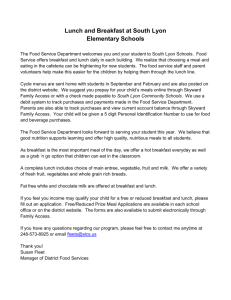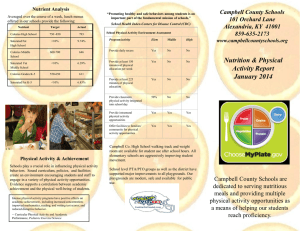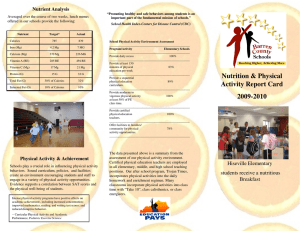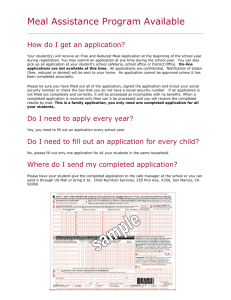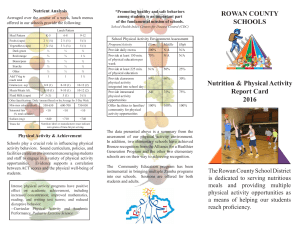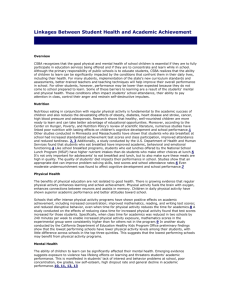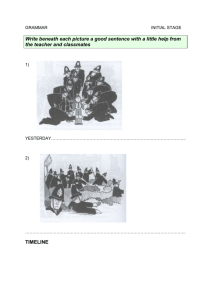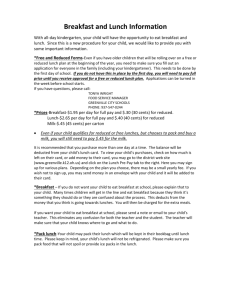2012-2013 Nutrition Report Card
advertisement
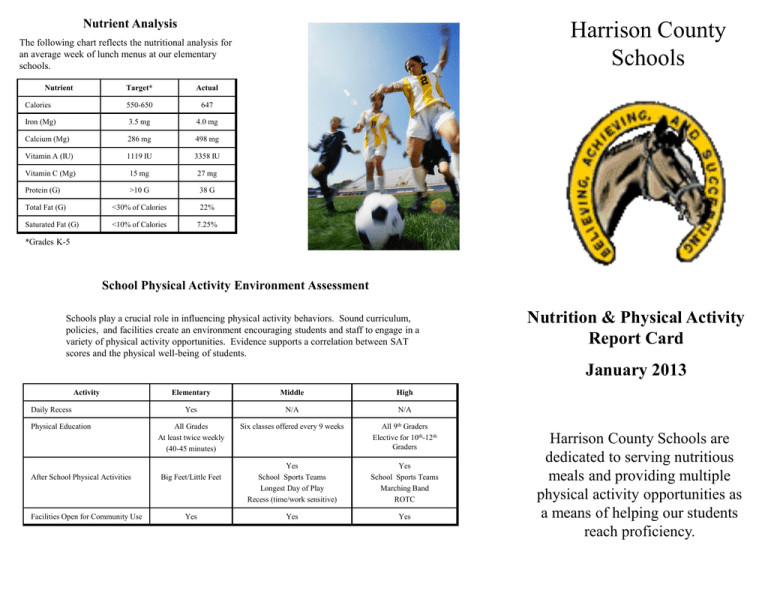
Nutrient Analysis Harrison County Schools The following chart reflects the nutritional analysis for an average week of lunch menus at our elementary schools. Nutrient Target* Actual Calories 550-650 647 Iron (Mg) 3.5 mg 4.0 mg Calcium (Mg) 286 mg 498 mg Vitamin A (IU) 1119 IU 3358 IU Vitamin C (Mg) 15 mg 27 mg Protein (G) >10 G 38 G Total Fat (G) <30% of Calories 22% Saturated Fat (G) <10% of Calories 7.25% *Grades K-5 School Physical Activity Environment Assessment Schools play a crucial role in influencing physical activity behaviors. Sound curriculum, policies, and facilities create an environment encouraging students and staff to engage in a variety of physical activity opportunities. Evidence supports a correlation between SAT scores and the physical well-being of students. Nutrition & Physical Activity Report Card January 2013 Activity Daily Recess Physical Education After School Physical Activities Facilities Open for Community Use Elementary Middle High Yes N/A N/A All Grades At least twice weekly (40-45 minutes) Six classes offered every 9 weeks All 9th Graders Elective for 10th-12th Graders Big Feet/Little Feet Yes Yes School Sports Teams Longest Day of Play Recess (time/work sensitive) Yes School Sports Teams Marching Band ROTC Yes Yes Harrison County Schools are dedicated to serving nutritious meals and providing multiple physical activity opportunities as a means of helping our students reach proficiency. National School Lunch School Breakfast The National School Lunch Program (NSLP) was conceived in 1946 as a “measure of national security to safeguard the health and well-being of the Nation’s children.” School districts receive federal reimbursement for each school lunch served that meets the United States Department of Agriculture nutrition guidelines. These guidelines promote meal quality while commodity donations help the farmer and help schools keep down meal prices. Our lunch meals are planned on a three-week menu cycle. Federal regulations require that we offer minimum portion sizes of meat, fruit and/or vegetable, grains/breads and fluid milk during every lunch meal service. The portion sizes are designed to meet the needs of growing children and, as a rule, we increase the sizes as the children grow older. The menu cycle provides for variety and allows us to make the most efficient use of the donated commodities, especially seasonal fresh fruits. We offer all low-fat milk choices as well as 100% fruit juices. The School Breakfast Program (SBP) was established in 1966. School districts receive federal reimbursement for each school breakfast served that meets the U.S. Department of Agriculture’s nutrition guidelines. SY 2009-2010 # Schools Participating 6 Total Breakfasts Served 185,123 Average Daily Participation Breakfast Prices 1115 Adult Price $1.50 Student Reduced-price: $ .30 Student Paid: $ 1.00 Elem $1.25 Middle/High Total Lunches Served 435,824 Average Daily Participation 2608 # Students Approved for Free Meals 1474 # Students Approved for Reducedprice Meals 283 # Students approved for Paid Meals 1466 Lunch Prices Adult: $2.75 Reduced-price : $.40 Paid : $ 1.75 Elem $ 1.95 Middle/High •We do not contract with retail establishments to provide entrée items. •A list of all food and beverage items available to students during the day is on file at central office. Daily menus available on district website. •Food and beverage items that are sold as extras on the cafeteria lines all meet the minimum nutritional standards required by the Kentucky Board of Education. No sales from soft drink machines or school stores take place until after 3:00 p.m. SY 2009-2010 6 -- Dr. J. Larry Brown, Tufts University School of Nutrition Studies show that children who participate in the School Breakfast Program have significantly higher standardized achievement test scores than non-participants. Children with access to school breakfast also had significantly reduced absence and tardiness rates. The table below provides a synopsis of the lunch program, including meals served and participation data. # Schools Participating “Protecting children’s health and cognitive development may be the best way to build a strong America.” RECOMMENDATIONS: Financial Information SY 2009-2010 Federal Reimbursement 983,247 USDA Commodities Received 85.258 All Other Income 713,132 Cost of Food Purchased 798,284 All Other Food Service Costs 794,654 Continue to increase breakfast participation at HCMS and HCHS Increase opportunities for all students to be active during the school day. Encourage more students to become involved in after school events that involve physical activity.
